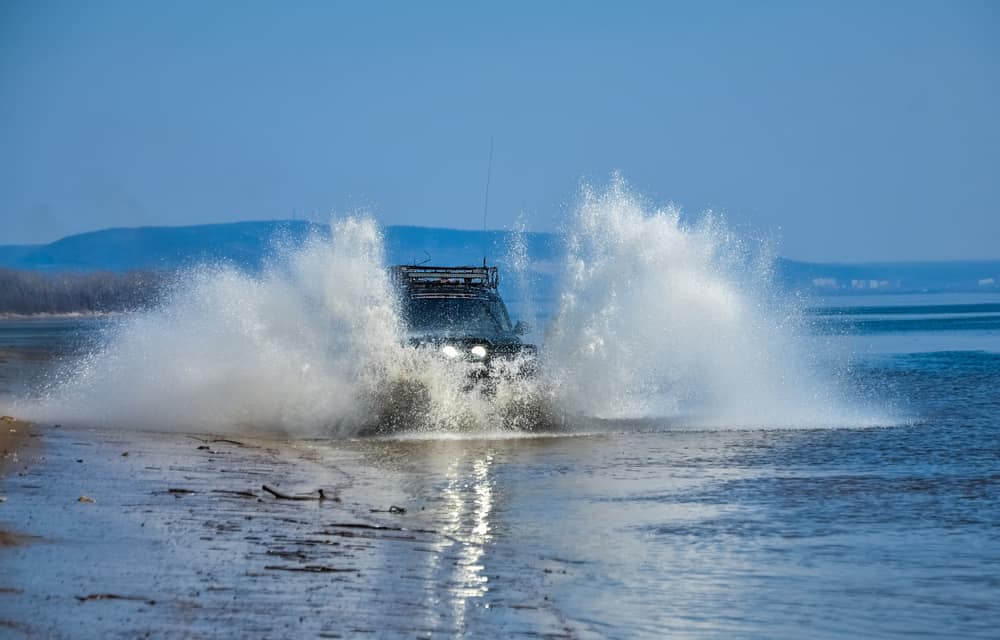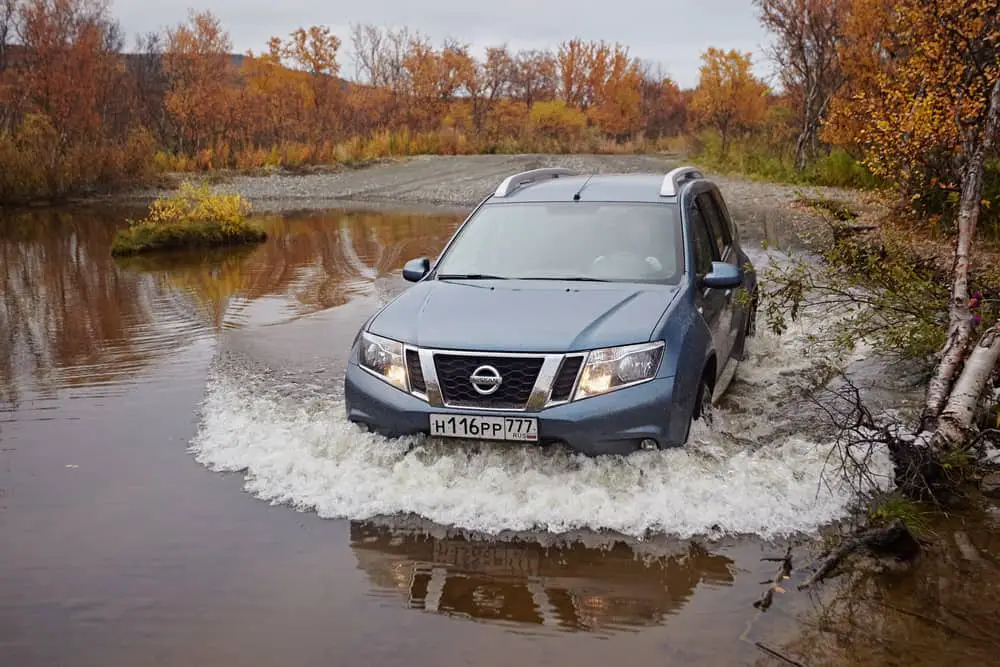
The appeal of driving in water is universal. River crossings or launching boats require that the tires of your vehicle will get wet. On most passenger vehicles, the air intake housing is low down on the vehicle, and driving in water deeper than the sidewall of your tires should be avoided. Off-road vehicles are designed with air intakes placed much higher in the engine bay. Many off-road enthusiasts have air intake snorkels fitted to draw in clean cold air from the roof level of the vehicle.
The wading depth of 4×4 vehicles is limited by the height of the air breather hoses on the front and rear differentials and the transfer case. The air intake and breather hoses can be extended to higher positions. A wading depth of more than 600mm should be avoided, even with extended air intakes.
When driving into the water, the sudden cooling of the air inside the front and rear differential housings and the transfer case housing will create a suction that will draw water into the housing. If the air breather hoses are below the water level or blocked, water will be sucked into the axle housing via the outer bearing seals. If not drained and replaced, this water will create an emulsion with the oil, and grease and damage to the internal gears are inevitable.
Though you have seen footage of vehicles fully submerged in water with just the snorkel air intake sticking out above the surface, such vehicles are thoroughly dried and maintained after immersion. Let’s look at some ways to take on water crossing without the risk of damage to your vehicle.
How To Assess A Water Crossing?
The best practice that all 4×4 trainers will teach you is never to guess how deep a body of water is. Even when the water is crystal clear, it may appear shallower than it is. Always stop and allow the engine and other underbody components of your vehicle to cool down. Driving into cold water with glowing hot components may cause metal parts to crack and deteriorate prematurely.
Using a walking stick to test the depth, walk through the water hazard and establish the depth and speed of the water. If you cannot walk through it, you cannot drive through it. The pressure of water against the side of a vehicle can easily wash the vehicle down the stream. If the water is deeper than the air intake of the engine or breather pipes, do not attempt to cross the water. If water is sucked into the engine’s air intake, the engine will stall, and you will be stuck in the water.
Consult the owner’s manual and establish the maximum wading depth of your 4×4 vehicle is. Standard vehicles mostly have a maximum wading depth of no more than 600mm. Make sure you know how deep you can go into the water as the consequence of water damage to the engine, differentials, and transfer cases may be as high as 75% of the vehicle’s purchase value.
How To Increase The Wading Depth Of Your 4×4
To increase the wading depth on your 4×4, you can install a breather kit consisting of extended breather hoses for the front differential, rear differential, and transfer case. The kit will also contain a snorkel system, purpose-designed for your make and model of vehicle.
The air intake snorkel has to be installed in such a way as to prevent water from being drawn into the junction of the snorkel tube to the air intake box. This junction has to be sealed in a water-tight manner. The air breather hose extensions must be routed into the body pillars of the vehicle as recommended by the installation instructions.
You should also check that no electronic components will become wet. Water ingress into the vehicle’s cabin is inevitable and may cause carpets to get damp and grow mold. The height of electronic components and the fuse box must also be established.
It is recommended not to drive through water where the depth is such that water will make its way onto the cabin. A wading depth no deeper than the hubs of the wheels is the safest depth at which to attempt a crossing. Give the vehicle a thorough cleaning and check for water ingress in the differentials, transfer case, and gearbox after your adventure. Even the smallest amount of water in the oil will cause a milky emulsion, and such oil needs to be drained, flushed, and replaced.

How To Drive Through A Water Hazard?
For vehicles fitted with differential locking capability, it is advised to engage the lockers before driving into the water, ensuring that all tires provide even forward traction.
The speed at which the vehicle enters the water must not be too high. Entering at a steady pace creates a bow-wave to form in front of the vehicle, the depth of the water is effectively reduced. Maintain a constant forward momentum and do not stop in the water.
If you enter the water at too a high speed, the water may splash up into the engine bay and cause sensitive electronics to get wet. The water should slash onto the windscreen and bonnet of the vehicle.
Keep going until the vehicle has completely exited from the water hazard, and then pull over to inspect the vehicle for any signs of damage or water ingress. If possible, avoid deep water crossings. Check for advice on the 4×4 trial that you are going to drive. Also, check whether rains in the upper catchment will not result in swollen rivers.
Never attempt water crossings alone. Be prepared to have your vehicle towed out of water or mud traps by having the required towing ropes and tow-eyes on your 4×4.
Conclusion
Your 4×4 vehicle has been designed to cope with severe off-road conditions, including water crossings. The wading depth of your vehicle is defined in the owner’s manual, and you should strictly adhere to it.
You can have the vehicle’s wading depth increased by fitting a manufacturer-approved breather kit and air intake snorkel. Try to avoid deep water and always check for signs of water ingress after an excursion.


